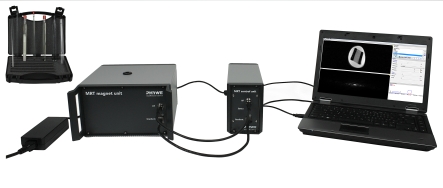
|
|
|||
|
Technical data Magnetic Resonance Imaging (MRI) IIArticle no: P5942500

Principle The aim of these experiments is to show how the spin echo technique can be used to generate 2D MR images of a slice of a well-defined thickness, orientation, and size (Localized Spin Echo 2D). These parameters determine the so-called "field of view" (FOV) of the MR image. We will introduce a method that enables the recording of 3D MR images (Spin Echo 3D). For this purpose, an additional phase encoding will be performed in the third dimension. Both methods include the automatic calibration of the system frequency with regard to the Larmor frequency. As a result, the MR image is more stable over several averaging steps. Benefits
Tasks
Learning objectives
Scope of delivery
|
|||
|
|
PHYWE Systeme GmbH & Co. KG
Robert-Bosch-Breite 10 – 37079 Göttingen – Germany
www.phywe.com
Robert-Bosch-Breite 10 – 37079 Göttingen – Germany
www.phywe.com

